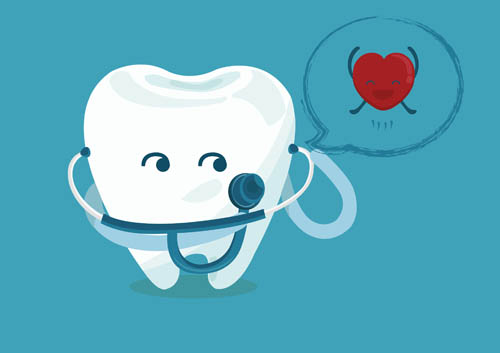Oral Health Problems: An indicator of overall health problems?
September 17th, 2025

If you are like many people, you might think of your oral health as separate from your overall health. After all, most dental coverage plans are distinct from health care coverage. However, your oral health goes far beyond being able to chew nutritious and enjoyable foods. Oral health problems may be an indicator of a variety of other health problems.
Links between Oral Health and Overall Health
In the late 1980s, researchers noticed a trend among patients who had recently suffered from heart attacks. As the Journal of the American Dental Association reported, they observed that these patients were more likely to have dental caries or cavities, periodontitis or inflammation around the tooth, and other forms of gum disease. Later studies found similar results, and dentists and doctors now recognize poor oral health as a risk factor for a variety of heart conditions, such as heart attacks, atherosclerosis, and coronary heart disease.
There are even more links between oral health problems and overall health problems. Some individuals do not find out that they have Type 2 diabetes until a dentist sees that they have periodontitis. If you have diabetes, worsening periodontitis can indicate that your diabetes is not under control.
Poor oral health is also associated with rheumatoid arthritis. Furthermore, poor oral health puts you at higher risk for respiratory infections, such as pneumonia, because harmful pathogens can enter your body through your mouth.
Take Care of Your Teeth
Keeping your teeth healthy remains important, especially as you grow older. Older adults are more prone to dental caries and other oral health problems, as well as to chronic diseases. While taking care of your oral health might not prevent a specific disease, a healthy mouth is a significant factor in your overall health.
You can take care of your teeth by continuing to brush twice a day and floss every day. Avoid consuming too many sugary and starchy foods, and drink water after each meal or snack to rinse your teeth. See Drs. Peter Vogel, Vijal Vadecha for regular checkups, and contact Daisy Mountain Dentistry if you have any concerns about your teeth or gums.
Chewing Gum: Fact and Fiction
September 10th, 2025

Remember all the things your parents would tell you when you were growing up to scare you away from doing something? Like how lying might make your nose grow, misbehaving meant you wouldn’t get money from the tooth fairy, and swallowed chewing gum would build up in your stomach and stay there for years?
Maybe that last one stayed with you well beyond your teens, and occurred to you every time you accidentally (or purposely) swallowed a piece of gum. We don’t blame you. It’s a scary thought.
But is it true?
We hate to take the fun out of parental discipline, but swallowing a piece of chewing gum is pretty much like swallowing any other piece of food. It will move right through your digestive system with no danger of getting stuck for months, let alone seven years.
This doesn’t mean you should start swallowing all your gum from now on, but if it happens accidentally now and then, there’s no need to panic.
Another common gum myth is that sugar-free gum can help you lose weight. Although it is preferable to choose sugar-free gum over the extra-sweet variety, no studies have show that sugar-free gum will help you lose weight.
If you pop a piece of gum in your mouth after dinner to avoid dessert, it could help you avoid eating a few extra calories every day. But the consumption of sugar-free gum without any other effort will not help you shed pounds.
If you really enjoy chewing gum, we strongly encourage you to select sugarless gum, because it lowers your risk for cavities. Many brands of sugarless gum contain xylitol, a natural sweetener that can, in fact, help fight bacteria that cause cavities and rinse away plaque.
So if you can’t kick the gum habit altogether, sugar-free is definitely the way to go!
If you have any questions about chewing gum, feel free to contact Drs. Peter Vogel, Vijal Vadecha at our Anthem office.
What was your favorite part of summer?
September 4th, 2025

It's the end of summer, and fall is just around the corner. Soon the temperatures will cool down, the leaves will start to change, and Drs. Peter Vogel, Vijal Vadecha and our team at Daisy Mountain Dentistry are sure that you’ll soon be thinking about Halloween costumes and Thanksgiving plans in no time. But wait! First, we want to know about your favorite parts of the summer! Did you go on a wonderful family trip? Did you pick up a new hobby? Did you try to spend as much time outside and in the sun as possible?
Share your favorite memories, stories, or photos with us by leaving a comment below or on our Facebook page.
Clean Toothbrush/Healthy Toothbrush
August 28th, 2025

We’ve all learned a lot about keeping healthy lately. Thorough hand washing, disinfecting cell phones and keyboards, wiping down shopping carts and door handles—all these low-maintenance cleaning habits can have a high impact on our health.
So, in that spirit, let’s talk about low maintenance cleaning routines for something you put in your mouth at least twice a day—your toothbrush.
Brushing Habits
Don’t let germs hitch a ride on your toothbrush before you even begin! Make sure your hands are clean before brushing, and rinse off your toothbrush before you put it in your mouth.
After brushing, be sure to rinse your brush carefully to get rid of leftover toothpaste, food particles, and other debris. And don’t forget to clean your toothbrush holder regularly. Talk to Drs. Peter Vogel, Vijal Vadecha or your hygienist when you visit our Anthem office for suggestions for deep cleaning brushes to eliminate bacteria if that’s a concern.
And while we’re talking about germs, how about…
- Flushing Habits
Most toothbrushes share their living space with another bathroom essential—the toilet. Every time we flush, microscopic particles are propelled through the air. And while no definitive relationship has been shown between flushing and disease transmission, closing the toilet lid before flushing is an easy way to reduce unpleasant particle transmission—and reduce the possible risk of toothbrush contamination.
- Airing? Yes!
Keeping a toothbrush in a dark, moist environment is the perfect setting for bacterial growth. Instead, let your toothbrush air dry after use in an upright position. Give it a shake first for a head start on the drying process.
- Sharing? No
We’re not talking about sharing a brush, which you would never do. We’re talking about sharing toothbrush holders. If your brush touches other brushes, you’re probably sharing germs as well as space, which can be especially problematic if someone in the house has immune concerns. Toothbrushes shouldn’t be too close to other toothbrushes, no matter how close you are to the other brush’s owner!
Finally, no matter how well you take care of your toothbrush, there comes a time when you must part with even the cleanest and best-maintained of brushes. After three or four months, bristles become frayed. This means you’re not getting the most effective plaque-removal from your brush. And to be on the safe side, consider retiring your toothbrush if you’ve been ill.
Dental self-care is a vital part of keeping yourself healthy, and a clean toothbrush is a simple way to support your oral health. High impact/low maintenance—win/win.


